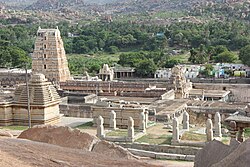War of the Goldsmith's Daughter: Difference between revisions
No edit summary Tags: Mobile edit Mobile web edit Advanced mobile edit |
No edit summary Tags: Mobile edit Mobile web edit Advanced mobile edit |
||
| Line 15: | Line 15: | ||
| combatant2 = [[Vijayanagar empire]] | | combatant2 = [[Vijayanagar empire]] | ||
| commander1 = [[Taj ud-Din Firuz Shah|Firuz Shah Bahmani]]{{WIA}}<br>[[Ahmad Shah I Wali]]<br>[[Devraj Ghorpade]]<ref name=":2">{{Cite book |first=M. S. | last=Ghorpade |url=https://archive.org/details/history-of-mudhol-state |title=History Of Mudhol State |pages=52}}</ref><br>Faulad Khan<br>Fazlullah Inju<br> Khan-i Khanan<br>Anapota Velama<br>Peda Komati Vema<br>Sarnaubat Siddu | | commander1 = [[Taj ud-Din Firuz Shah|Firuz Shah Bahmani]]{{WIA}}<br>[[Ahmad Shah I Wali]]<br>[[Devraj Ghorpade]]<ref name=":2">{{Cite book |first=M. S. | last=Ghorpade |url=https://archive.org/details/history-of-mudhol-state |title=History Of Mudhol State |pages=52}}</ref><br>Faulad Khan<br>Fazlullah Inju<br> Khan-i Khanan<br>Anapota Velama<br>Peda Komati Vema<br>Sarnaubat Siddu | ||
| commander2 = [[Deva Raya I]]{{ | | commander2 = [[Deva Raya I]]{{Surrendered}} | ||
}} | }} | ||
Revision as of 23:22, 27 June 2025
| The War of the Goldsmith's Daughter | |||||||||
|---|---|---|---|---|---|---|---|---|---|
| Part of Bahmani–Vijayanagar Wars | |||||||||
 A temple from the capital of Vijayanagar | |||||||||
| |||||||||
| Belligerents | |||||||||
|
Bahmani Sultanate Reddi Kingdom Velama chiefs | Vijayanagar empire | ||||||||
| Commanders and leaders | |||||||||
|
Firuz Shah Bahmani (WIA) Ahmad Shah I Wali Devraj Ghorpade[1] Faulad Khan Fazlullah Inju Khan-i Khanan Anapota Velama Peda Komati Vema Sarnaubat Siddu |
Deva Raya I | ||||||||
The capital of the Vijayanagar empire, which was besieged by Bahmanis | |||||||||
The War of the Goldsmith's Daughter[2] or the Bahmani–Vijayanagar War of 1406[3] was a significant conflict between the Bahmani Sultanate and the Vijayanagar Empire, the two primary powers in the Deccan region of thirteenth and fourteenth century India, occurring in 1406. Led by Tajuddin Firuz Shah, the Bahmani forces, supported by Velama chiefs and the Reddis, launched multiple attacks on the Vijayanagar empire ruled by Deva Raya I. Despite his initial resistance, Deva Raya suffered heavy casualties, ultimately leading to the acceptance of the terms imposed by the Bahmanis, ending the war.
Following the Bahmani–Vijayanagar war of 1398, Bahmani ruler Firuz Shah directed his attention northward to quell Rajput rebellions within his territories. Meanwhile, the Vijayanagar ruler Harihara II passed away in 1404, sparking a succession struggle among his sons, namely Virupaksha Raya, Bukka Raya II, and Deva Raya I. Although Virupaksha Raya briefly ascended to the Vijayanagar throne, his reign lasted only a few months before his brother Bukka Raya II took over. However, in 1406, Deva Raya I ousted Bukka and proclaimed himself king of Vijayanagar.
Following Deva Raya I's ascension, a Brahmin saint returning from pilgrimage in Banaras recounted his encounter with a goldsmith's daughter named Parthal in Mudgal Doab, praising her beauty, musical prowess, and other virtues. Intrigued by the Brahmin's description, Deva Raya dispatched him to Parthal's home to propose marriage on his behalf. However, Parthal, mindful of the recent succession turmoil in Vijayanagar and aware of the fate of girls who ventured to the kingdom that they never came back to their families, as well as the practice of Sati, declined Deva Raya's proposal. Instead, she expressed a desire to wed an Islamic prince.
Infuriated by the rejection, Deva Raya personally led his army to Mudgal to abduct Parthal. Sensing the impending threat, the goldsmith sought refuge in Bahmani territories. In response, the Bahmani Governor of Mudgal Doab, Faulad Khan, confronted and defeated the Vijayanagar forces, repelling their invasion.
Upon learning of Deva Raya's aggression, Firuz Shah personally led the Bahmani forces, bolstered by allies from the Reddi Kingdom and Velama chiefs who harbored grievances against Vijayanagar over territorial disputes. Initially encountering resistance, the Bahmani forces persevered and launched multiple assaults on Vijayanagar strongholds.
As the campaign progressed, the Bahmanis seized the strategic Bankapur region, a major trade center, and systematically conquered various Vijayanagar territories. Faced with overwhelming odds, Deva Raya had no choice but to seek peace and surrender. Accepting the terms imposed by the Bahmanis, Deva Raya agreed to relinquish all lands captured by the Bahmanis during the campaign as dowry, return the territories taken from the Reddis and Velamas, and offer his daughter in marriage to Firuz Shah.
The treaty, though humiliating for Deva Raya, marked the end of the conflict, with the marriage between Parthal, the daughter of the goldsmith, and Hassan Khan, the son of Firuz Shah, cementing the agreement between the two powers.
- ↑ Ghorpade, M. S. History Of Mudhol State. p. 52.
- ↑ Bingham, Woodbridge; Conroy, Hilary; Iklé, Frank William (1964). A History of Asia. Allyn and Bacon. p. 220.
- ↑ Jaques, Tony (2006-11-30). Dictionary of Battles and Sieges: A Guide to 8,500 Battles from Antiquity through the Twenty-first Century [3 volumes]. Bloomsbury Publishing USA. p. 1075. ISBN 978-0-313-02799-4.
